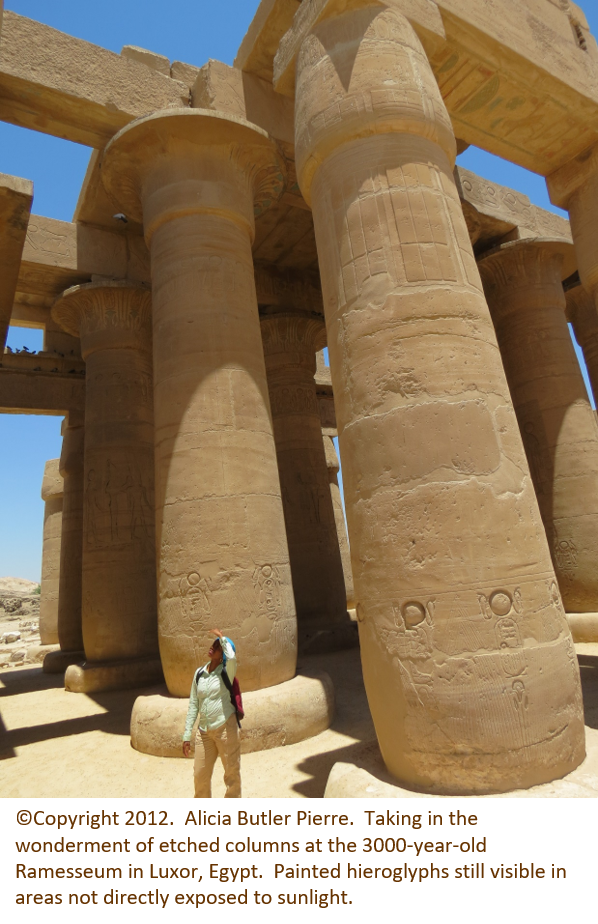When most people think of Ancient Egypt, visions of pyramids usually come to mind.
But they built more than pyramids.
For example, the above image is of the Ramesseum. It’s a mortuary temple built for Pharaoh Ramses II. I included this image because it illustrates, undeniably, the magnitude of scale – my husband and I are barely noticeable!
You see it’s one thing to build and grow something. It’s another to scale it.
So what does it mean to actually scale?
Growth vs. Scale
Don’t worry, this isn’t an exercise in semantics. However, it is worth noting that the words “growth” and “scale” are often misused interchangeably in business.
Growth usually happens incrementally over an extended period. It refers to more orders, clients, projects, etc. that result from marketing-related activities (i.e., P.R., publicity, advertising). The increase in business is at a steady pace and requires more people (and maybe equipment, space and capital), but for the most part, it’s manageable.
On the other hand, scale takes your business to another stratosphere. It refers to not only more business, but also the upgrades to commercial, enterprise and factory-level people, processes and tools. Scale is all about operational capacity. That is, the ability to align capacity with capability so that you can successfully meet customer demand.
Scale is a form of hyper-growth – almost like growth to the hundredth power and it often happens over a shorter period.
Scale = Growth100
Without the proper foundation to support this type of growth, chaos ensues. Left unchecked for too long, it can lead to implosion.
What Does Scale Look Like?
Below is an excellent example of what scale looks like from billionaire Sara Blakely, Founder & CEO of Spanx®. She shared these posts on LinkedIn regarding her growth-to-scale journey:
GROWTH:
SCALE:
Scale allowed the:
- Ancient Egyptians to build larger-than-life temples, tombs, universities, and libraries, much of which is still standing or yet to be unearthed and whose construction baffles and astounds modern-day architects and engineers;
- STEM professionals at NASA to go from paper planes to rocket launchers and place people on the moon.
- Ancient Chinese to build an army of over 8,000 life-size terracotta soldiers to guard the remains of the first emperor of China.
When I worked as a chemical engineer and had to explain to people what I did, I would tell them that “I take the few liters of a substance that a chemist produces in a lab and scale it to produce several tons of that substance per hour.”
Make sense?
How Does Scale Happen?
Scale can happen either organically or inorganically. When your business receives positive publicity, it’s exciting! The spotlight attracts more customers and the cash flows in. All of a sudden, your company has reached what Malcolm Gladwell describes as a “tipping point.” This tipping point causes a surge in demand for your product or service.
That surge may be temporary…or permanent. Organic scale is a natural progression of the growth spurts your company has experienced. Inorganic scale happens when your ability to meet customer demand is compromised consistently and you are forced to level up operational capacity. It looks something like this – check out John’s story:
Sustainability – Tips from the Ancients
Scale requires a solid foundation for sustainability. Even an earthquake wasn’t a match for the Ramesseum. Although the heads of the statues toppled over, the foundation of the temple and its columns are mostly intact.
To this day, there is debate regarding how the ancient Egyptians carved stone and erected buildings that have literally stood the test of time. But what many Egyptologists and architects agree on is the factors necessary to produce at this level of scale:
- Teams: There was a definite hierarchy to support their building projects. Every project was constructed
 with intent and purpose. Work was divided among aptitude starting with apprentice all the way up to master builder. These teams could easily get into the thousands and required skillful organization and coordination to achieve these architectural feats.
with intent and purpose. Work was divided among aptitude starting with apprentice all the way up to master builder. These teams could easily get into the thousands and required skillful organization and coordination to achieve these architectural feats.
- Continuous education. Imagine going to school for 40 years before you could begin practicing your craft. This was the reality for many in Ancient Egypt, including the high priests. They valued continuous education and training and understood that learning is a lifetime endeavor.
- Build to Last. No planned obsolescence here! Construction on a mortuary temple and/or tomb began the moment a new pharaoh was installed. Builders worked with the knowledge that a project may not be finished in their lifetime. Perfection, consistency, and quality control supported the type of scale and longevity desired. Carvings of the Metu Neter (hieroglyphs) into the stone sometimes went 6-10” deep as a safeguard against erosion from exposure to the outside elements. And the columns at most temples are so massive that up to 100 adults can stand on top of one at the same time!
Help is Here!
Got more business than you can handle? Are you ready to scale your company’s operations? Schedule an appointment with me to learn how to apply the proven KasennuTM methodology to your business. Not only will you scale your business for the spotlight, but you’ll never have to reject more business again because of capacity constraints.












